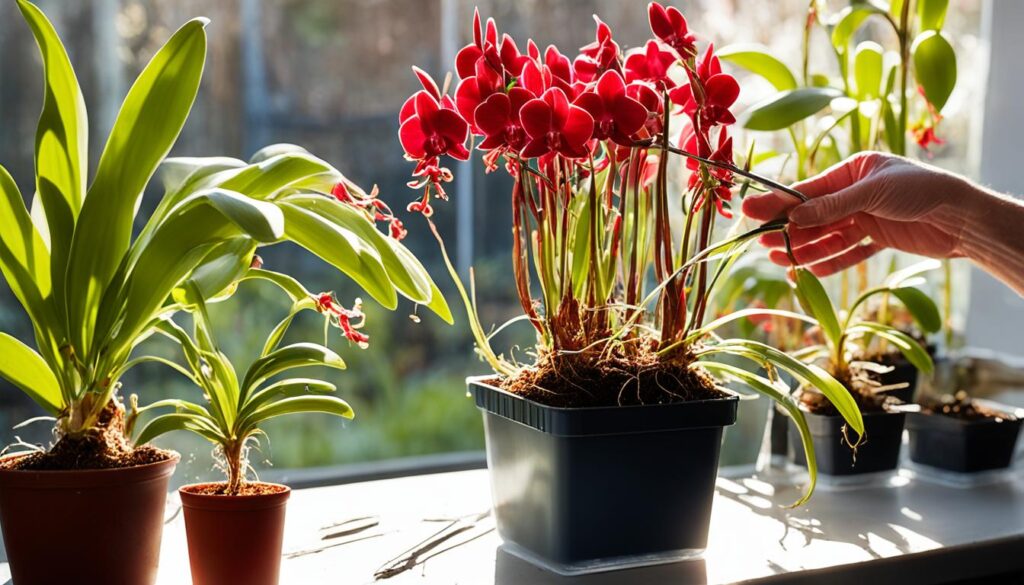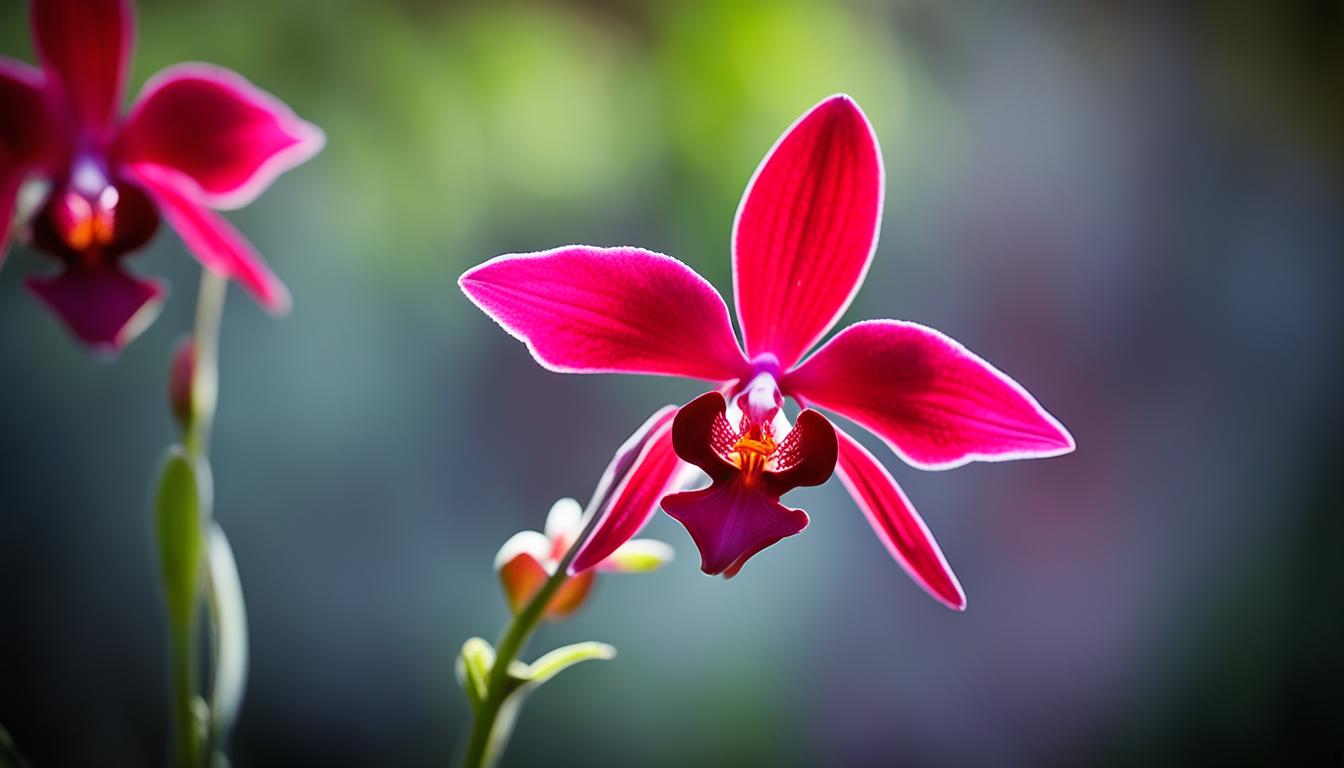In the diverse world of orchid plants, a mere 0.01% exhibit naturally occurring red flowers.
Amidst this scarcity, red orchids emerge as striking emblems of exotic beauty, pulling collectors into a fascinating quest for these captivating blooms.
Known among enthusiasts for their rarity and breathtaking presence, rare orchid varieties with true red hues are undisputed treasures in the kingdom of beautiful red flowers.
For me, the pursuit of collecting red orchids is akin to embarking on a thrilling adventure.
Each authentic red orchid species I encounter elevates my collection, forging a connection to the symbiosis of rarity and beauty that defines these stunning adornments of the natural world.
Key Takeaways
- True red orchids are astonishingly rare, accounting for a tiny fraction of the orchid family.
- Spotting an authentic red orchid is critical due to the common practice of artificially coloring blooms to satisfy demand.
- Phalaenopsis orchids, including Buddha’s Treasure and Red Jaguar, stand out as accessible yet opulent choices for collectors.
- Exotic varieties such as Vanda Magic Red and Cattleya Chien Ya Champion offer a spectrum of reds and enrich the world of orchid collecting.
- By recognizing and caring for genuine red orchid plants, collectors ensure the health and longevity of these splendid specimens.
Discovering the Majesty of Red Orchids and Their Varieties
The pursuit of rare orchid varieties often leads enthusiasts to the extraordinary beauty of red orchids.
With their vibrant hues and uncommon presence, these orchid plants stand as symbols of passion and strength within the floral kingdom.
In my journey to understand the significance and care of these botanical treasures, I have uncovered a wealth of knowledge and fascination, which I’m eager to share.
Understanding the Rarity of True Red Orchids
The quest for the elusive true red in orchid plants is as challenging as it is rewarding.
Beautiful red flowers such as red orchids carry a symbolic weight that transcends their aesthetic value, signaling love and desire, making them sought-after by collectors and enthusiasts alike.
Their scarcity in the wild necessitates an eye for genuine qualities that set apart authentic blooms from artificially enhanced ones.
The Allure of Phalaenopsis: The Most Common Red Orchid
Among the pantheon of orchid varieties, Phalaenopsis orchids, or moth orchids, remain the paragon of red orchid symbolism.
Their capacity to adapt to indoor environments and maintain a continuous display of blooms has made them a favorite for both beginners and seasoned growers.
The Phalaenopsis genus offers an array of reds, with cultivars such as Phalaenopsis Buddha’s Treasure and Phalaenopsis Kimono celebrated for their smaller, yet intensely red flowers.
Exotic Varieties: Vandas, Cymbidiums, and Cattleyas
Stepping beyond the common, the realm of exotic orchid varieties presents a dazzling array of reds. Vandas, Cymbidiums, and Cattleyas showcase a range of deep reds to bright burgundies, making any orchid collection an exhibition of nature’s splendor.
Acknowledging their unique needs is essential in how to care for red orchids, ensuring that each species receives the attention required to thrive.
Let’s explore and compare a few of these exotic red orchids with a concise table:
| Orchid Variety | Color Palette | Flowering Traits | Care Tips |
|---|---|---|---|
| Vanda Magic Red | Vibrant burgundy | Long peduncles with numerous blooms | High humidity and bright, indirect light |
| Cattleya Chien Ya Champion ‘Red Apple’ | Radiant red petals | Consistent bloomer, hassle-free upkeep | Intermediate temperatures and moderate watering |
| Cymbidium red Kerby Merlot | Dark red with yellow/white accents | Stunning, showy flowers | Cooler temperatures and bright light |
Each of these exotic orchid varieties – the remarkable Vandas, the luxurious Cymbidiums, and the opulent Cattleyas – offers a unique set of characteristics and care requirements that, when adhered to, blossom into a festival of red captivates any who gaze upon them.
In admiring these astonishing examples of beautiful red flowers, we can further appreciate their distinct roles within the red orchid symbolism, representing not only beauty but the rarity and exotic charm inherent in all rare orchid varieties.
Red Orchids
As a dedicated enthusiast of red orchids, I find it essential to share my expertise on how to care for red orchids with fellow admirers.
These exotic beauties require meticulous attention to truly thrive, and I am here to provide valuable orchid care tips that will ensure the prosperity of your red orchids.
Caring for Your Crimson Beauties: Tips and Tricks
Understanding the nuances of red orchid care starts with recognizing their basic needs, which are not overly complex but are crucial for their survival and bloom longevity. Here’s what you need to foster the health of your red orchids:
- Maintain consistent moisture but avoid overwatering to prevent root rot.
- Provide moderate temperatures as extreme heat or cold can damage your orchids.
- Ensure adequate lighting; diffused sunlight is perfect for red orchids to flourish.
- Mimic their natural tropical habitat’s humidity levels, aiming for about 40-70%.
I often find myself lost in the beauty of my orchids’ blooms, making it all worthwhile.
Repotting Practices for Optimal Red Orchid Health
Repotting is a vital aspect of orchid care, particularly for red orchids, as it rejuvenates the plant and encourages growth.
Let me share the optimal practices for repotting orchids.
| Orchid Type | Pot Preferences | Substrate | Repotting Timing |
|---|---|---|---|
| Dendrobiums | Small, snug pots to support tall pseudobulbs | Regular orchid mix with good drainage | When new growth emerges after blooming |
| Lycaste & Catasetum | Larger pots to accommodate their growth | Seedling mix or fine-grade bark | Early spring or after flowering |
| Phalaenopsis | Clear pots to monitor root health | Sphagnum moss or fine bark | Every 1-2 years or when the medium breaks down |
Each time I repot my orchids, it’s like preparing them for a new chapter in their life that will inevitably lead to more stunning red displays.

In conclusion, nurturing red orchids can be a joyous and fulfilling hobby. With the right orchid care tips and attentive repotting practices, your red orchids will not just survive but will thrive, bringing a touch of the exotic to your living space.
Conclusion
The exploration of red orchids reveals a glimpse into a world where beauty converges with the profound symbolism of passion and vitality.
These beautiful red flowers do more than dazzle the eye; they enliven the spirit, reflecting an unspoken narrative of vigor and allure.
The essence of red orchid symbolism is best appreciated through direct interaction with these exquisite plants.
As I have immersed myself in their care, I’ve come to understand the commitment they require to truly thrive.
Cultivating these floral gems has taught me not just how to care for red orchids, but also patience and attentiveness.
From ensuring the Phalaenopsis receives just the right amount of moisture, to admiring the Cattleya’s extravagant blooms, every aspect of nurturing these plants becomes a rewarding endeavor.
Not to mention the timeless elegance inherent in the Cymbidium species, their structured grace further endows any collection with an exotic presence.
Therein lies the culmination of this botanical journey: the reward of nurturing a living piece of art.
Red orchids carry with them the kind of splendor that does not simply furnish a space, but transforms it.
They infuse the air with a touch of the tropics, an invitation to marvel at the intricate dance of nature.
To tend to these red orchids is to partake in a practice as ancient as it is fulfilling, ensuring their legacy of rare beauty endures in the warmth of attentive care.
FAQ
What are some popular types of red orchid species?
Red orchid varieties include the Phalaenopsis species such as Phalaenopsis Buddha’s Treasure, Phalaenopsis Red Jaguar, and Phalaenopsis Kimono. Other exotic orchid varieties that feature red flowers are Vanda Magic Red, Cattleya Chien Ya Champion ‘Red Apple’, Cattleytonia Why Not ‘Roundabout’, and Cymbidium varieties like Cymbidium red kerby merlot and Cym Rich wealth red ruby.
Why are true red orchids so rare?
True red orchids are rare due to their limited natural occurrence. Many orchids that are sold as red are often artificially enhanced with dyes or paints to create the illusion of a red flower. Genuine red orchids are prized for their beauty and can be challenging to find in the market.
How do I care for my red orchid?
Caring for red orchids requires understanding their specific needs. For instance, Phalaenopsis orchids thrive with consistent moisture and moderate temperatures, while Vandas need more light and higher humidity. Each variety, including Cattleyas and Cymbidiums, may have unique care requirements you should become familiar with, such as varying water, light, and temperature needs.
When is the best time to repot red orchids?
The best time to repot red orchids is usually after their blooming cycle is complete and when new growth is evident. Repotting during this time allows the orchid to acclimate to its new pot and medium with minimal stress.
What kind of potting mix should I use for red orchids?
Choose a potting mix that suits the specific species of orchid you have. Some, like Dendrobiums, may prefer a more minimalistic potting mix, while others, such as Lycaste and Catasetum, might require particular substrate grades, like a seedling mix.
What is the symbolism of red orchids?
Red orchids symbolize passion, desire, strength, and courage. Their vibrant color is as captivating as their rarity, making them a powerful symbol in floral arrangements and as gifts.
How often should I water my red orchids?
Watering frequency depends on the type of orchid you have. Typically, red orchids like to stay moderately moist but not waterlogged. It is important to let the top inch of the potting medium dry out between waterings to prevent root rot.
Do red orchids need special lighting conditions?
Yes, red orchids generally require bright, indirect light to thrive. Direct sunlight can burn their leaves, so it’s ideal to provide them with diffused light that mimics their natural, tropical environment.
Are red orchids difficult to grow?
Growing red orchids can be challenging due to their specific care requirements, but with the right knowledge and conditions, they can flourish. The key is to replicate their natural habitat as much as possible, with appropriate light, temperature, and humidity levels.
Can I grow a red orchid from a seed?
Growing orchids from seed is a complex process that typically involves sterile laboratory conditions and is not usually recommended for casual home gardeners. For most enthusiasts, buying a mature plant is the best way to add a red orchid to their collection.


Leave a Reply